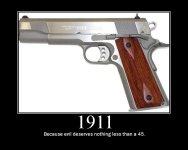The poll needs altered to S&W Victory...covering any model there of.
I own 2, and as far as sidearms go..a K frame S&W isnt horrible in the time of 7-8 shot autos with tiny sights and often bloodletting ergonomics.(most of which I have owned over the years)
The U.S. did buy a number of .38S&W caliber Victories alongside the .38 special ones...notible users of the .38S&W/.38-200 was the O.S.S.,some domestic police departments supplied though the Defence Supply Corporation, and Some civilian Security Guards at U.S. Military bases.
Federal agencies/State police/Tennesee Valley Authority and others were known to also buy .38 Special Victories through the DSC
While in general the UK favored the 5" barrels, and the U.S. 4"......the U.S. also purchased 5",6", and 2" barreled models, and so did the Brits. There is nothing written in stone when it comes to these.
On the Broom handle Mauser...where do you get that most shoulder stocks were destroyed in combat? Nope, if you seen a German with a RED9 he usually has whole thing....and it would be his primary weapon.(no rifle)
I own 2, and as far as sidearms go..a K frame S&W isnt horrible in the time of 7-8 shot autos with tiny sights and often bloodletting ergonomics.(most of which I have owned over the years)
The U.S. did buy a number of .38S&W caliber Victories alongside the .38 special ones...notible users of the .38S&W/.38-200 was the O.S.S.,some domestic police departments supplied though the Defence Supply Corporation, and Some civilian Security Guards at U.S. Military bases.
Federal agencies/State police/Tennesee Valley Authority and others were known to also buy .38 Special Victories through the DSC
While in general the UK favored the 5" barrels, and the U.S. 4"......the U.S. also purchased 5",6", and 2" barreled models, and so did the Brits. There is nothing written in stone when it comes to these.
On the Broom handle Mauser...where do you get that most shoulder stocks were destroyed in combat? Nope, if you seen a German with a RED9 he usually has whole thing....and it would be his primary weapon.(no rifle)
Last edited:


